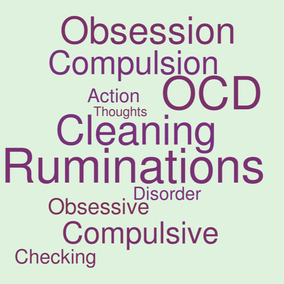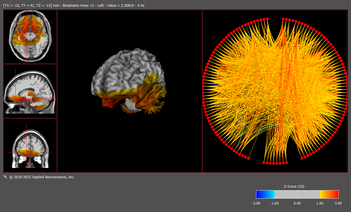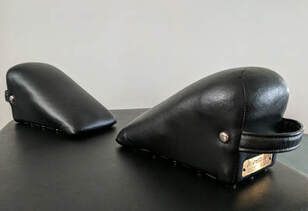 Obsessive Compulsive Disorder (OCD) is comprised of two parts: obsessions and compulsions. Obsessions are thoughts and compulsions are behaviors. OCD is classified as an anxiety disorder because it is generally driven by anxiety. Obsessions are unwanted, intrusive thoughts that cause a person distress. Compulsions are behaviors in which a person engages to reduce the anxiety caused by the obsessions. Common compulsions that the general public is familiar with include when people will engage in checking behaviors and cleaning behaviors. The variations of presentation of OCD are quite extensive and not the focus of this blog entry. But whatever the presentation, OCD can be a debilitating condition. Some of the more effective treatments for OCD historically has been exposure therapy and cognitive behavioral therapy. Medications, especially selective serotonin reuptake inhibitors and tricyclic antidepressants, are generally most effective for OCD. But medication is not able to help all cases. Additionally, medications can have unwanted side effects. Some people refuse to engage on exposure therapy because it is by definition unpleasant.  Brain image of a patient with OCD who has elevated activity in various locations in the brain related to OCD symptoms. Brain image of a patient with OCD who has elevated activity in various locations in the brain related to OCD symptoms. Neurofeedback offers another treatment for OCD which can be very effective in treating all components of OCD including anxiety, obsessions and compulsions. In my office, a brain map (also known as qEEG analysis) is conducted to identify areas of the brain that have been found in research to relate to OCD. Areas of the brain frequently found dysregulated include the cingulate gyrus, anterior cingulate gyrus and orbitofrontal cortex (Brodmann area 11). Other regions can be involved including other parts of the frontal cortex, insula and the amygdala, which drives anxiety. I almost always find excessive theta wave activity in the anterior cingulate in patients with OCD. After identifying which specific areas of the brain are dysregulated, Neurofeedback can be done to retrain these areas of the brain linked to OCD symptoms. Patients then report improvement in OCD symptoms. I do additional testing such as the Yale-Brown Obsessive Compulsive Scale (Y-BOCS) to get baseline measures of function and then track improvement. When Y-BOCS scores are normalized, treatment stops. I then track patients over a period of 6 weeks to see if scores remain normalized. In all the cases of OCD I have treated, the improvements made are permanent and no other therapy is needed. Some research has been done on OCD and Neurofeedback. Articles are listed below. If you or someone you know suffers from OCD, help is out there. Please contact my office in Palm Harbor, Florida and schedule an appointment.
0 Comments
 SOT® uses wedge-shaped blocks placed under the pelvis to gently yet effectively bring the body, especially the sacroiliac joint, back into balance. SOT® uses wedge-shaped blocks placed under the pelvis to gently yet effectively bring the body, especially the sacroiliac joint, back into balance. In October of 2021, I received my Advanced Proficiency level of certification in Sacro Occipital Technique (also spelled Sacro Occipital Technic ® or SOT®). I already had a general certification in SOT®. This advanced certification documents a level of mastery in specific advanced parts of SOT®, including Chiropractic Manipulative Reflex Technique (CMRT) and chiropractic craniopathy. CMRT deals with the function of the organs in the body. It includes visceral manipulation to treat dysfunction in the organs that are contributing to people's problems. Conditions I frequently treat with CMRT are respiratory problems (including viral illnesses), allergies, gallbladder issues, stomach and digestive problems, adrenal dysfunction, liver issues, kidney issues, constipation, diarrhea, heartburn, gastroesophageal reflux disease (GERD), menstrual problems, menopause symptoms, and prostate issues. There are so many issues that can be helped with chiropractic craniopathy, since 80% of your nervous system is in your brain. Some of the more frequent ones I help in my office are headaches, traumatic brain injury, temporomandibular dysfunction (TMD; including dysfunction of the temporomandibular joint [TMJ]), trigeminal neuralgia, learning disabilities, tooth pain, dizziness, and vertigo. Babies' heads are often traumatized by the birth process, leading to problems like plagiocephaly, difficulty nursing or latching, and ear infections which can all be helped by chiropractic craniopathy. Chiropractic adjustments that do not hold can indicate an unresolved cranial bone issue. Since the brain controls the rest of your body, I've had cranial adjustments help things like neck pain, low back pain, sciatica, lymph drainage, and even ankle problems (really!). I am the only chiropractor in Pinellas County Florida with Advanced Proficiency SOT® level certification. Interested in knowing if SOT® can help you? Please contact my office to schedule an appointment. |
AuthorI'm a Chiropractic Physician, Psychotherapist and researcher. I'm interested in helping people live their lives to their full potential. That could be simply without pain. Or it could be without more complicated physical or mental health problems. Or it could be getting help in making changes in their life so that they can achieve their dreams. Archives
June 2023
Categories |
 RSS Feed
RSS Feed